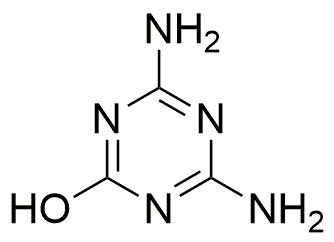Ammeline is widely utilized in research focused on:
- Analytical Chemistry: It serves as a reagent for detecting and quantifying certain metal ions, enhancing the accuracy of analytical methods.
- Agricultural Chemistry: Ammeline is investigated for its potential use in developing herbicides, providing a targeted approach to weed management.
- Pharmaceutical Research: Its unique structure allows for exploration in drug formulation, particularly in creating compounds with specific biological activities.
- Polymer Science: Ammeline can be used in synthesizing specialty polymers, contributing to advancements in materials with tailored properties.
- Environmental Chemistry: It is studied for its role in the degradation of pollutants, offering insights into sustainable practices for environmental remediation.
General Information
Properties
Safety and Regulations
Applications
Ammeline is widely utilized in research focused on:
- Analytical Chemistry: It serves as a reagent for detecting and quantifying certain metal ions, enhancing the accuracy of analytical methods.
- Agricultural Chemistry: Ammeline is investigated for its potential use in developing herbicides, providing a targeted approach to weed management.
- Pharmaceutical Research: Its unique structure allows for exploration in drug formulation, particularly in creating compounds with specific biological activities.
- Polymer Science: Ammeline can be used in synthesizing specialty polymers, contributing to advancements in materials with tailored properties.
- Environmental Chemistry: It is studied for its role in the degradation of pollutants, offering insights into sustainable practices for environmental remediation.
Documents
Safety Data Sheets (SDS)
The SDS provides comprehensive safety information on handling, storage, and disposal of the product.
Product Specification (PS)
The PS provides a comprehensive breakdown of the product’s properties, including chemical composition, physical state, purity, and storage requirements. It also details acceptable quality ranges and the product's intended applications.
Certificates of Analysis (COA)
Search for Certificates of Analysis (COA) by entering the products Lot Number. Lot and Batch Numbers can be found on a product’s label following the words ‘Lot’ or ‘Batch’.
*Catalog Number
*Lot Number
Certificates Of Origin (COO)
This COO confirms the country where the product was manufactured, and also details the materials and components used in it and whether it is derived from natural, synthetic, or other specific sources. This certificate may be required for customs, trade, and regulatory compliance.
*Catalog Number
*Lot Number
Safety Data Sheets (SDS)
The SDS provides comprehensive safety information on handling, storage, and disposal of the product.
DownloadProduct Specification (PS)
The PS provides a comprehensive breakdown of the product’s properties, including chemical composition, physical state, purity, and storage requirements. It also details acceptable quality ranges and the product's intended applications.
DownloadCertificates of Analysis (COA)
Search for Certificates of Analysis (COA) by entering the products Lot Number. Lot and Batch Numbers can be found on a product’s label following the words ‘Lot’ or ‘Batch’.
*Catalog Number
*Lot Number
Certificates Of Origin (COO)
This COO confirms the country where the product was manufactured, and also details the materials and components used in it and whether it is derived from natural, synthetic, or other specific sources. This certificate may be required for customs, trade, and regulatory compliance.


